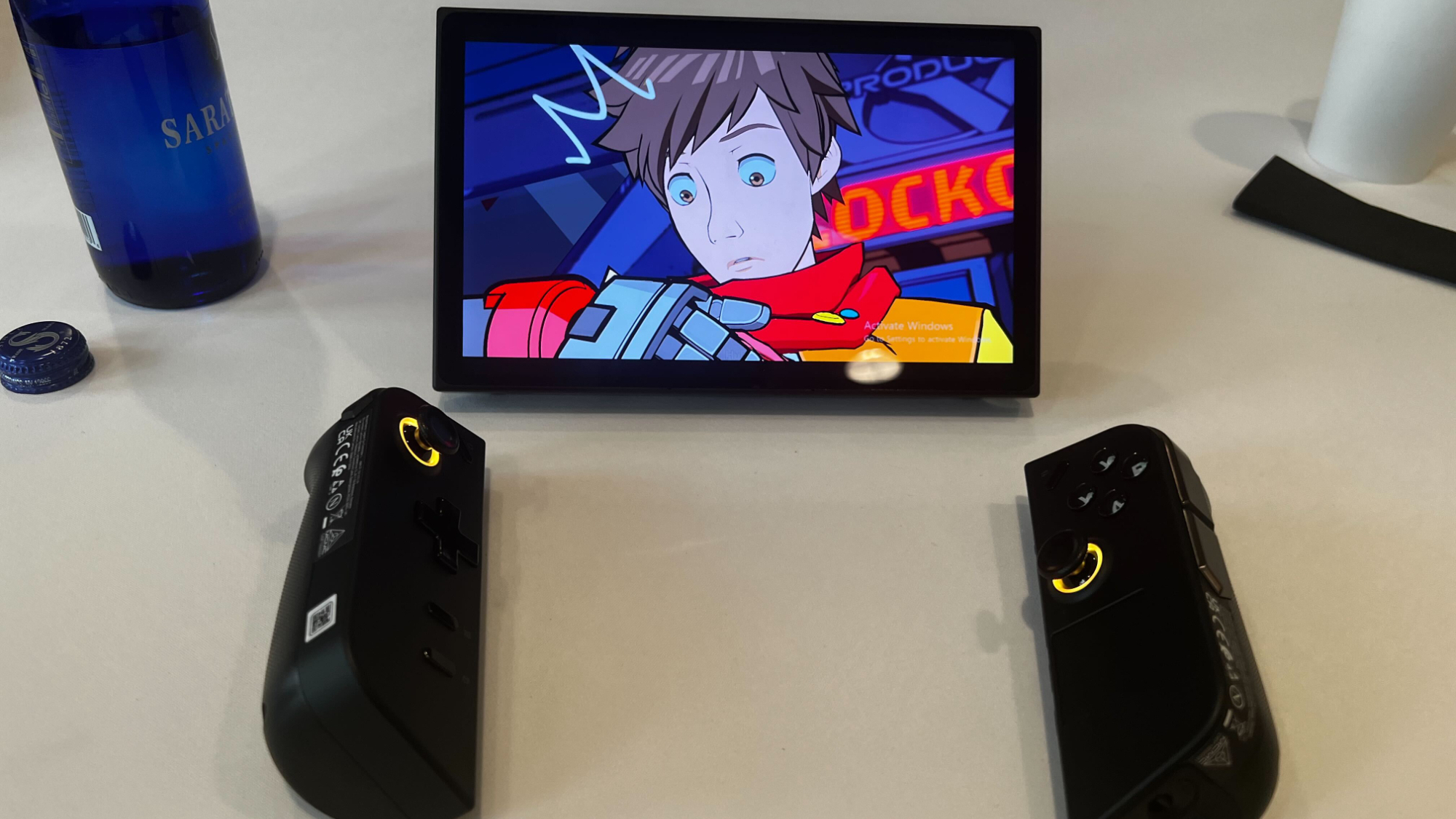
Lenovo's massive new handheld PC is more than just a chonky Nintendo Switch.
You might have seen some leaked images of Lenovo’s Legion Go handheld PC a few weeks ago. At a recent event, I actually got a chance to hold Lenovo’s curious handheld in my two hands. After spending some time with it, Lenovo is definitely going for something a bit more ambitious than the Switch or even the Steam Deck.
The first thing that jumps out when using the Legion Go is its size. It’s been listed at around 854 grams (1.88 lbs), making it heavier than the Steam Deck and nearly double the weight of the Nintendo Switch (.88 lbs).
In a way, I’m grateful the gamepads detach because I couldn’t see myself holding this thing for a long time without getting tired. That’s right; the gamepads are completely detachable, like the Nintendo Switch. The right gamepad features a small trackpad beneath the right thumbstick and a mouse scroll near the top. In addition to triggers and shoulder buttons, the entire Legion Go boasts six additional programmable buttons.
In a way, I’m grateful the gamepads detach because I couldn’t see myself holding this thing for a long time without getting tired. That’s right; the gamepads are completely detachable, like the Nintendo Switch. The right gamepad features a small trackpad beneath the right thumbstick and a mouse scroll near the top. In addition to triggers and shoulder buttons, the entire Legion Go boasts six additional programmable buttons.
The biggest surprise about the gamepads is something called FPS Mode. The Legion Go comes with a circular stand for the right controller. This same controller incorporates a switch on its underside that activates FPS Mode. Once engaged, it takes on an appearance akin to a flight stick, but in actuality, it functions as a mouse that can be maneuvered across a surface.
The rear triggers serve as the left and right mouse buttons, while the mouse scrolls near the top of the controller function as the mouse wheel. I tested out a couple of first-person games, such as Doom Eternal and Powerwash Simulator. While it offered more precision than its rather stiff thumbsticks, adapting to this mouse-like function took time due to its unfamiliarity. Achieving the right sensitivity setting also proved to be a gradual process.
A weird thing I noticed in FPS mode is that the right thumbstick uncomfortably presses into the center of your palm. The joystick is deactivated in this mode, but it seems strange that you can’t stow it away in this mode. On a positive note, the Legion Go includes a substantial kickstand that effectively holds it upright on a table, making it a perfect console to sit on a tray table on an airplane.
(Image credit: Future)
(Image credit: Future)
(Image credit: Future)
(Image credit: Future)
(Image credit: Future)
Steam Deck review: Our verdict on Valve’s handheld.
Best Steam Deck accessories: Get decked out.
Steam Deck battery life: What’s the real battery life?
The true potential of FPS Mode appears to lie not so much in first-person shooters but rather in games that traditionally benefit from a mouse, such as Baldur’s Gate 3 or Diablo 4 where mouse movement is preferred. Ideally, with the left game controller, you’d map addition abilities.
The Go has Bluetooth connectivity, allowing for pairing with a wireless controller. The optimal setup, I think, would entail placing it on a tabletop using its sizable kickstand and a wireless controller.
The most impressive attribute of the Legion Go is its screen. Boasting a huge 8.8-inch vibrant QHD+ (2560 x 1660) IPS touch display with a rapid 144Hz refresh rate; it’s undoubtedly the standout feature. During a brief session playing Hi-Fi Rush, the vivid cel-shaded graphics truly popped on the screen.
Under the hood, the Legion Go is powered by an AMD Ryzen Z1 Extreme APU, akin to the ROG Ally. In my limited demonstration, game performance appeared satisfactory. Doom Eternal ran smoothly, yet game compatibility posed a more considerable issue. Attempting to play Ori and the Will of the Wisps, pre-installed on my demo unit, revealed a failure to recognize the gamepad. Additionally, Doom Eternal encountered compatibility hiccups in FPS mode, occasionally failing to recognize the gamepad as a mouse.
(Image credit: Future)
(Image credit: Future)
(Image credit: Future)
I asked about additional accessories at launch, like docking stations or controller grips like you’d find on the Switch, but Lenovo said it’s got nothing of the sort at release. However, nothing is stopping a third party from filling that void. The Legion Go will be compatible with Lenovo’s Legion AR Glasses, which is set to drop in October for $330. I used the Legion Glasses paired with a Legion Go, which let me use it essentially as an external monitor directly in front of my eyeballs. It’s incredibly jarring at first but pretty neat. If you wear glasses, you can get special prescription lenses made so they are not blurry when you use them.
Since it is a Windows 11 device, you can play, install, and play games from various platforms and digital storefronts like Xbox, Epic Games Store, and Steam. Lenovo did say Legion Go will come with its own game launcher in addition to your typical Windows 11 desktop. Though it wasn’t ready when I tried the device out. Considering how close we are to seeing this at retailers, it was concerning not to see its own launcher since all of your controller mappings will be handled through this absent launcher.
Aside from the handful of Xbox Game Pass titles preloaded on the device, I could not conduct benchmarking or install any other games. My gameplay sessions included about 15 minutes with Hi-Fi Rush, Powerwash Simulator, and Doom Eternal, the latter requiring a sufficiently smooth frame rate for effective play. Fortunately, I encountered no noticeable slowdowns in these sessions.
(Image credit: Future)
The battery life of the Legion Go still remains a mystery, though, considering the specs, I wouldn’t be surprised if it’s on par with the ROG Ally (just under an hour), considering the Legion has a bigger, brighter screen that’s sure to drain some serious juice. Another thing I’m curious about is how hot this thing runs after more than 20 minutes of gameplay and if it will get as loud as the Steam Deck on more hardware-intensive games.
The Legion Go has some clever ideas. However, until we get a better sense of its battery life and launcher functionality, it’s tough to gauge whether Lenovo has successfully crafted a bona fide Windows 11-based competitor to the Steam Deck. We have seen a few of those already, like the AOKZOE A1 Pro and the ROG Ally, which are rather good. However, the key for most we’ve tested has been the inclusion of a robust launcher and shortcut UI built-in to the OS.
The Lenovo Legion Go is set to be released in October, starting at $700.






